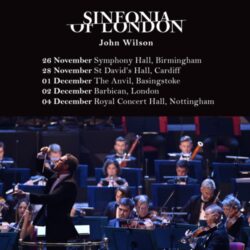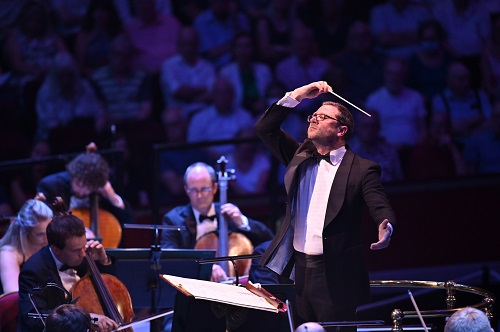 United Kingdom Walton, Ravel, Gershwin, Debussy: Martin James Bartlett (piano), Sinfonia of London / John Wilson (conductor). The Anvil, Basingstoke, 1.12.2022. (NB)
United Kingdom Walton, Ravel, Gershwin, Debussy: Martin James Bartlett (piano), Sinfonia of London / John Wilson (conductor). The Anvil, Basingstoke, 1.12.2022. (NB)

Walton – Scapino Overture
Ravel – Valses Nobles et Sentimentales
Gershwin – Rhapsody in Blue
Debussy – La Mer
Ravel – Boléro
When John Wilson relaunched the Sinfonia of London the concept was for a hand-picked group recording studio projects only. The early acclaim of the first releases led to equally acclaimed appearances at the BBC Proms. Now for the first time, Wilson is taking his freelance orchestra on the road for a concentrated tour of five concerts in just over a week with the performance in Basingstoke the third. For the curious, the interest lies in seeing how successfully this hugely talented group of individual players are able to mould themselves into a whole for concert purposes. The simple answer is superbly well. What the group might lack in terms of familiarity based on years of playing together is balanced by individual and collective virtuosity and musical personality. Also by being able to focus essentially on a single programme (a couple of other works they have already recorded are being swapped in for the London performance at the end of this week) the players, and more to the point, Wilson is able to focus on music that suits their style and temperament best. Not for them the requirements of a season’s concertising having to tick repertoire boxes. Instead, we were given a programme of music that could display the formidable talents of this orchestra front and centre.
The Anvil in Basingstoke is an ideal hall and acoustic for this type of large-scale music making and Wilson was willing to unleash the full power of the orchestra when required. The concert opened with Walton’s brilliant and witty Scapino Overture. Apart from the brio of the performance I have to say I enjoyed hearing a concert open with an overture again! This was an ideal choice as it showcased the qualities that have brought the orchestra much praise. Ensemble is wonderfully tight, rhythms are razor sharp, dynamic range is very wide – the energy that emanates from the stage is palpable. Alongside that, woodwind and string principals took their sinuous and alluring solos with great skill and expressive freedom. This was another recurring feature of the entire concert with solo instruments given a licence to play with character and individuality. As yet the orchestra has not yet released a disc containing any Walton, but my guess is that alongside the Partita they played at the 2022 Proms there is some already in the can. This is the sort of work that Walton wrote superbly – as well as any composer, yet it has been neglected in concert in recent years. One other feature of Wilson’s performing style appeared – an inclination to whip up the tempo of certain passages, especially towards climactic moments. Make no mistake this orchestra play those ferocious tempi when other ensembles might be scrabbling around but there is an interpretative question about ‘aptness’. Possibly the bubbling good humour of the overture was replaced by a muscular bravura but certainly the audience responded very warmly to this with cheers and sustained applause after every work in the concert. Good to see the Anvil fuller than at recent concerts.4

Wilson spoke briefly and affably from the podium a couple of times during the concert very well I thought. His comments were an interesting addition to the already very good and extensive programme notes but more importantly they removed the stage/audience divide. Ravel’s Valses Nobles et Sentimentales followed – a work which alongside Bolero has already appeared in the Wilson/Sinfonia discography and it was the highlight of that disc for me when I reviewed it for MusicWeb International. Again it showcases the many virtues of the orchestra collectively and individually. The woodwind solos in particular had a sensual beauty that was strikingly effective. Likewise, all of the strings sections played with an intensity and tonal weight right to the back desks. This creates a body of tone – regardless of dynamic – that is full yet flexible – again qualities that it is a delight to hear live. This is by no means a ‘pops’ work so good to hear it in this context this well played.
Most certainly a pops work is Rhapsody in Blue. The orchestra was joined by Martin James Bartlett. He won the BBC Young Musician of the Year as far back as 2014 but he is still just twenty-six years old. He is a big and confident musical personality and he played the work with ease. Like Wilson, there is a tendency to make tempi and dynamic extremes and for the only time in the concert this did cause problems of balance and ensemble between orchestra and soloist. There was a distinct sense that the players were struggling to hear exactly where they were trying to fit their parts. Of course, this is the problem of touring a programme to different halls with different pianos and limited time to ‘fix’ such issues at the pre-concert rehearsal/sound check. Again rhythms snapped, the big orchestral solos were taken with panache and personality – I am sure I saw a couple of the brass ‘wah-wah’ (hat-mute) solos crack a smile from colleagues. The presence of the saxophones (the standard Ferde Grofé orchestration was used) added a bar-room glamour and again were beautifully played. Bartlett’s performance received cheers and an ovation from the audience – personally I was less convinced. The extremes of tempo and expressivity risk a work that is already quite ‘bitty’ becoming fragmented and there was a sense that some of the articulations in the extended central solo/cadenza became gabbled. But important to note that the pleasure of both players and audience was evident – so much so that Bartlett gave a performance of Earl Wild’s Ravelian version of ‘Embraceable You’ as an appropriate and very effectively nonchalant encore.
The second half opened with another twentieth-century masterpiece – Debussy’s La Mer. Again, Wilson generally favoured swift tempi but the particular delight here were the sheer diversity and complexity of the orchestral sonorities whether the richly burnished brass chorales or the wonderfully balanced passage for solo celli to name but two. The difficulties of this score are many for even the finest orchestras with so much inner detail requiring intricate interlacing between instrumental groups. This is an area in which the Sinfonia of London excel – for example the many flickering harp figurations registered in a way too often overlooked. This was an interpretation strong on the muscular dynamism of the score – not characteristics often associated with Debussy – and as such it made for an exciting and compelling performance. My sense is that this will become a great performance when Wilson pulls back from the sheer intoxicating energy he generates and finds a subtler balance between the extremes and allows more expressive warmth into the reading.
The concert concluded with the ever-popular Bolero. Perhaps the work is almost too popular but curiously and perhaps because of that it is more likely to feature in a summer ‘classical hits’ concert than a programme such as this. Wilson assured the audience they were probably hearing the Basingstoke premiere of the ‘original’ ballet version of the score. This is the version the orchestra recorded and aside from a couple of instrumental tweaks – most notably the antiphonal side drums – there is little audible difference for even the most knowledgeable listener. Sensibly Wilson pretty much let the orchestra play the piece on their own – he put down the baton he had used through the rest of the concert and simply cued sections as required. Unsurprisingly all of the wind and brass solos were played with exceptional beauty and character – again the saxophones were strikingly sensuous with an interesting contrast in use of vibrato. The tempo here was pretty much ideal with a steady tread but one that draws the music inexorably forward. The final modulation and ultimate collapse is always a piece of musical theatre and brilliantly achieved here.
There is a central paradox here. The Sinfonia of London is a relatively young orchestra not just as an ensemble but in terms of the average age of the players. But they prove what those in the field of orchestral playing have known for some years – the individual and collective standard of playing has never been higher. The orchestra play at a level that any orchestra of any country at any time would be proud to achieve. Yet, the future for live Classical Music seems more under threat than ever with funding reduced and venues struggling to fill halls in the post-Covid age. Clearly on the strength of the reception here there is an appetite for the finest music played in the finest manner and nothing quite matches hearing what can be achieved by such skilled musicians in concert. Aside from the technical skill on display there was a very appealing sense of collective enjoyment and respect amongst all the performers that is genuinely a pleasure to see. The orchestra will be touring again next Autumn, and I would urge anyone who lives near one of the venues to grab a ticket – this is an orchestra where the reality joyfully matches the hype.
Nick Barnard